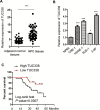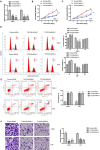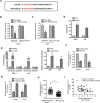Silencing of long non-coding RNA TUC338 inhibits the malignant phenotype of nasopharyngeal cancer cells via modulating the miR-1226-3p/FGF2 axis
- PMID: 36224455
- PMCID: PMC9556687
- DOI: 10.1007/s12672-022-00544-8
Silencing of long non-coding RNA TUC338 inhibits the malignant phenotype of nasopharyngeal cancer cells via modulating the miR-1226-3p/FGF2 axis
Retraction in
-
Retraction Note: Silencing of long non-coding RNA TUC338 inhibits the malignant phenotype of nasopharyngeal cancer cells via modulating the miR-1226-3p/FGF2 axis.Discov Oncol. 2024 Oct 23;15(1):583. doi: 10.1007/s12672-024-01466-3. Discov Oncol. 2024. PMID: 39441225 Free PMC article. No abstract available.
Abstract
Long noncoding RNAs (lncRNAs) have been suggested as essential regulators in the cancer progression. LncRNA TUC338 was found to promote the malignancy of various cancers, however, the involvement of TUC338 in nasopharyngeal cancer (NPC) has not been well characterized. Here, our results found the significant overexpression of TUC338 in NPC tissues. Higher level of TUC338 was also observed in NPC cells. Interestingly, NPC patients harboring overexpressed TUC338 have worse prognosis. Functional study indicated that down-regulated TUC338 remarkably suppressed the NPC cell proliferation and cell migration. Notably, depletion of TUC338 significantly inhibited the in vivo tumor growth. Mechanistically, TUC338 acted as molecular sponge of miR-1226-3p and attenuated the negative regulation of miR-1226-3p on the expression of fibroblast growth factor 2 (FGF2). Down-regulation of TUC338 inhibited FGF2 expression in NPC cells and tumor tissues. Overexpression of FGF2 attenuated the suppressed NPC proliferation upon the depletion of TUC338. Our results demonstrated the novel function of TUC338/miR-1226-3p/FGF2 axis in NPC progression, suggesting the potential diagnosis and therapeutics significance of TUC338 in NPC.
Keywords: FGF2; NPC; TUC338; miR-1226-3p.
© 2022. The Author(s).
Conflict of interest statement
The authors declare no competing interests.
Figures






Similar articles
-
Circular RNA circ_0000615 knockdown suppresses the development of nasopharyngeal cancer through regulating the miR-338-3p/FGF2 axis.Neoplasma. 2020 Sep;67(5):1032-1041. doi: 10.4149/neo_2020_191019N1061. Epub 2020 May 26. Neoplasma. 2020. PMID: 32453598
-
Retraction Note: Silencing of long non-coding RNA TUC338 inhibits the malignant phenotype of nasopharyngeal cancer cells via modulating the miR-1226-3p/FGF2 axis.Discov Oncol. 2024 Oct 23;15(1):583. doi: 10.1007/s12672-024-01466-3. Discov Oncol. 2024. PMID: 39441225 Free PMC article. No abstract available.
-
Long non-coding RNA PTPRG-AS1/microRNA-124-3p regulates radiosensitivity of nasopharyngeal carcinoma via the LIM Homeobox 2-dependent Notch pathway through competitive endogenous RNA mechanism.Bioengineered. 2022 Apr;13(4):8208-8225. doi: 10.1080/21655979.2022.2037364. Bioengineered. 2022. PMID: 35300558 Free PMC article.
-
LncRNA RHPN1-AS1 promoted cell proliferation, invasion and migration in cervical cancer via the modulation of miR-299-3p/FGF2 axis.Life Sci. 2019 Dec 15;239:116856. doi: 10.1016/j.lfs.2019.116856. Epub 2019 Sep 13. Life Sci. 2019. PMID: 31525429
-
HOXD-AS1 facilitates cell migration and invasion as an oncogenic lncRNA by competitively binding to miR-877-3p and upregulating FGF2 in human cervical cancer.BMC Cancer. 2020 Sep 25;20(1):924. doi: 10.1186/s12885-020-07441-9. BMC Cancer. 2020. PMID: 32977766 Free PMC article.
Cited by
-
Epigenetic priming of an epithelial enhancer by p63 and CTCF controls expression of a skin-restricted gene XP33.Cell Death Discov. 2023 Dec 8;9(1):446. doi: 10.1038/s41420-023-01716-3. Cell Death Discov. 2023. PMID: 38065940 Free PMC article.
-
Traditional Banxia Xiexin decoction inhibits invasion, metastasis, and epithelial mesenchymal transition in gastric cancer by reducing lncRNA TUC338 expression.Heliyon. 2023 Oct 20;9(11):e21064. doi: 10.1016/j.heliyon.2023.e21064. eCollection 2023 Nov. Heliyon. 2023. PMID: 37964840 Free PMC article.
-
Involvement of transcribed lncRNA uc.291 in hyperproliferative skin disorders.Biol Direct. 2023 Dec 1;18(1):82. doi: 10.1186/s13062-023-00435-0. Biol Direct. 2023. PMID: 38041107 Free PMC article.
-
p63: a crucial player in epithelial stemness regulation.Oncogene. 2023 Nov;42(46):3371-3384. doi: 10.1038/s41388-023-02859-4. Epub 2023 Oct 17. Oncogene. 2023. PMID: 37848625 Free PMC article. Review.
-
MIR210HG Accelerates the Progression of Colorectal Cancer and Affects the Function of Colorectal Cancer Cells by Downregulating miR-1226-3p.Turk J Gastroenterol. 2024 Nov 28;35(12):889-899. doi: 10.5152/tjg.2024.23669. Turk J Gastroenterol. 2024. PMID: 39641246 Free PMC article.
References
-
- Wei WI, Sham JS. Nasopharyngeal carcinoma. Lancet. 2005;365:2041–54. 10.1016/S0140-6736(05)66698-6. - PubMed
-
- Sun Y, et al. Induction chemotherapy plus concurrent chemoradiotherapy versus concurrent chemoradiotherapy alone in locoregionally advanced nasopharyngeal carcinoma: a phase 3, multicentre, randomised controlled trial. Lancet Oncol. 2016;17:1509–20. 10.1016/S1470-2045(16)30410-7. - PubMed
-
- Huarte M. The emerging role of lncRNAs in cancer. Nat Med. 2015;21:1253–61. 10.1038/nm.3981. - PubMed
-
- Mercer TR, Dinger ME, Mattick JS. Long non-coding RNAs: insights into functions. Nat Rev Genet. 2009;10:155–9. 10.1038/nrg2521. - PubMed
Publication types
LinkOut - more resources
Full Text Sources
